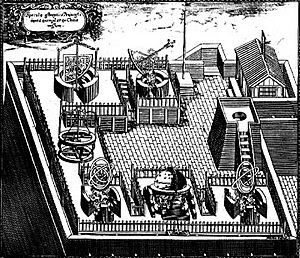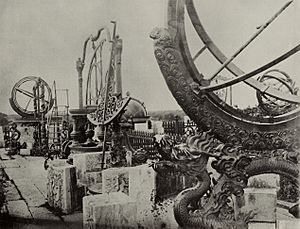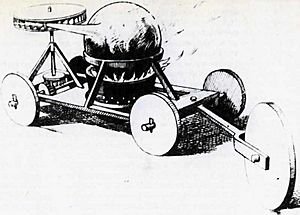Ferdinand Verbiest facts for kids
Quick facts for kids
Fr. Ferdinand Verbiest S.J.
|
|
|---|---|
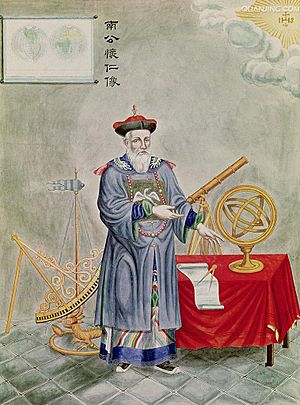
Portrait of Ferdinand Verbiest
|
|
| Born | 9 October 1623 |
| Died | 28 January 1688 (aged 64) Beijing, Qing dynasty, China
|
Father Ferdinand Verbiest (born October 9, 1623 – died January 28, 1688) was a Flemish Jesuit missionary who lived in China during the Qing dynasty. He was born in Pittem, a town near Tielt in what is now Belgium. In Chinese, he was known as Nan Huairen (南懷仁).
Verbiest was a very skilled mathematician and astronomer. He showed the court of the Kangxi Emperor that European astronomy was more accurate than Chinese astronomy. Because of this, he helped correct the Chinese calendar. Later, he was asked to rebuild and update the Beijing Ancient Observatory. He became the head of the Mathematical Board and the director of the Observatory.
He became good friends with the Kangxi Emperor. The emperor often asked Verbiest to teach him about geometry, philosophy, and music. Verbiest also worked as a diplomat, mapmaker, and translator. He could speak many languages, including Latin, German, Dutch, Spanish, Hebrew, Italian, and Manchu. He wrote over thirty books.
In the 1670s, Verbiest designed what some people believe was the first self-propelled vehicle. Many call this the world's first automobile, even though it was small and there's no clear proof it was actually built.
Contents
Becoming a Missionary in China
Ferdinand Verbiest was the oldest child of Joos Verbiest, who worked as a bailiff and tax collector in Pittem, Belgium. Ferdinand studied humanities with the Jesuits in Bruges and Kortrijk. After that, he went to the Lelie College in Leuven for a year to study philosophy and mathematics. He joined the Society of Jesus (Jesuits) on September 2, 1641.
Verbiest continued his studies in theology in Seville, Spain, where he became a priest in 1655. He finished his studies in astronomy and theology in Rome. He had originally wanted to be a missionary in Central America. However, his path led him to the Far East. The Roman Catholic Church was sending missionaries there to make up for the people who had left the Catholic faith in Europe for Protestantism.
On April 4, 1657, Verbiest left for China from Lisbon, Portugal. He traveled with Father Martino Martini, thirty-five other missionaries, and other passengers. Their boat arrived in Macau on July 17, 1658. Sadly, by then, most of the passengers, including many missionaries, had died.
Verbiest's first job in China was in Shaanxi province, where he led a mission until 1660. Then, he was called to Beijing to help Father Johann Adam Schall von Bell. Schall von Bell was the Jesuit Director of the Beijing Observatory and head of the Mathematical Board. Verbiest was meant to assist him and eventually take over his work in astronomy.
However, the political situation changed a lot in 1661. The young Shunzhi Emperor died at age 23. His son and successor, Xuanye (the Kangxi Emperor), was only 7 years old. So, the government was run by four regents. Unlike the Shunzhi Emperor, these regents did not like the Jesuits. As a result, the Jesuits faced more difficulties.
Proving European Astronomy
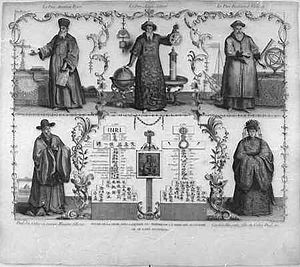
In 1664, a Chinese astronomer named Yang Guangxian challenged Schall von Bell to a public astronomy competition. Yang had written a paper against the Jesuits. Yang won the competition and took Schall von Bell's place as the head of mathematics. After losing, Schall von Bell and the other Jesuits were put in prison and accused of teaching a false religion.
A high court wanted to give them a very harsh punishment. But on April 16, 1665, a strong earthquake hit the part of the prison where they were to be punished. Also, a strange meteor was seen in the sky, and a fire destroyed part of the imperial palace. People saw these events as a sign, and all the prisoners were released. However, they still had to face trial. All the Jesuits except Verbiest, Schall von Bell, and two others were sent away to Canton. Schall von Bell died within a year because of the harsh conditions he had faced.
In 1669, the Kangxi Emperor took full power by having the corrupt regent, Oboi, arrested. In the same year, the emperor learned that there were serious mistakes in the calendar for 1670, which Yang Guangxian had created. Kangxi ordered a public test to see which was better: European or Chinese astronomy.
The test involved predicting three things:
- The length of a shadow cast by a tall pole at noon on a certain day.
- The exact positions of the Sun and planets on a specific date.
- The precise time of an upcoming lunar eclipse.
Yang and Verbiest each had to use their math skills to find the answers. "The Heavens would be the judge." The contest took place at the Bureau of Astronomy. Important government ministers and observatory officials watched. Unlike Yang, Verbiest had the latest information from European astronomy tables and used telescopes to help him. He succeeded in all three tests.
Verbiest was immediately made the Head of the Mathematical Board and Director of the Observatory. Because of him, the Jesuits who had been sent away were allowed to return to their missions. Yang Guangxian was sentenced to the same punishment he had wanted for Verbiest, but his sentence was changed to exile. He died on his way home.
Working with the Emperor
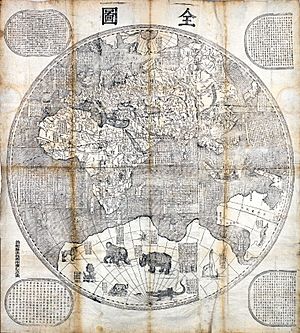
The 1670 calendar had an extra month that wasn't needed. It was added to hide other errors and to make the lunar months match the solar year. Verbiest bravely suggested that these errors should be fixed, including removing the extra month. This was a bold move because the emperor himself had approved the calendar. The observatory officials were scared of the emperor's reaction and begged Verbiest to change his mind. But he replied, "I cannot make the heavens agree with your calendar. The extra month must be taken out." To their surprise, the emperor studied Verbiest's research, agreed, and the changes were made.
After this, Verbiest and the emperor became true friends. Verbiest taught the emperor geometry, philosophy, and music. The emperor often invited him to the palace and to join him on trips across the empire. Verbiest translated the first six books of Euclid into Manchu. He also used every chance to share information about Christianity. In return, the emperor gave him a very high rank in the government and allowed him to preach Christianity anywhere in the empire.
Verbiest worked on many projects. He built an aqueduct, which is a channel for water. He also helped cast 132 cannons for the imperial army. These cannons were much better than any Chinese weapons before them. He also designed a new type of gun carriage. He created star charts for the Kangxi Emperor to help tell time at night. Other inventions included a steam engine to power ships.
New Instruments for Beijing Observatory
After fixing the calendar problems, Verbiest created a table showing all solar and lunar eclipses for the next 2000 years. The emperor was very pleased and gave him full control of the imperial astronomy observatory. Verbiest rebuilt it in 1673. The old equipment was outdated, so Verbiest moved it to a museum. Then, he designed six new instruments:
- Altazimuth: Used to measure the position of stars and planets in the sky.
- Celestial globe: A large globe, six feet wide, used to map and find objects in space.
- Ecliptic armilla: A large armillary sphere, six feet wide, used to measure positions of celestial bodies along the ecliptic (the Sun's path).
- Equatorial armilla: Another large armillary sphere, six feet wide, mainly used to measure true solar time and positions of celestial bodies.
- Quadrant Altazimuth: A large quarter-circle instrument, six feet in radius, for measuring how high celestial bodies are in the sky.
- Sextant: An instrument, eight feet in radius, used to measure the angle between two objects in the sky. It helps sailors find their location by measuring the Sun's angle at noon.
These instruments were very large and made of brass. They were beautifully decorated with bronze dragons supporting them. Even though they were heavy, they were easy to use. This showed how good Verbiest was at designing machines.
Verbiest's Steam 'Car'
Besides his work in astronomy, Verbiest also experimented with steam power. Around 1672, he designed a steam-powered trolley as a toy for the Kangxi Emperor. This might have been the first working steam-powered vehicle, or "auto-mobile." Verbiest described it in his book Astronomia Europea, which he finished in 1681. A friar brought the book to Europe, and it was printed in Germany in 1687. In this book, Verbiest first used the word "motor" in its modern meaning. He wrote that with one load of coal, the vehicle could move for more than an hour.
The vehicle was only about 65 centimeters (25 inches) long. It was a small model, not meant to carry people or goods. So, it's not exactly a "car" in the way we think of it today. However, it was the first vehicle that could move by its own engine power.
Since the steam engine as we know it wasn't invented yet, Verbiest used a different method called an impulse turbine. Steam was made in a round boiler. It came out through a pipe at the top and was aimed at a simple, open "steam turbine" (like a water wheel). This turbine then turned the back wheels.
It's not certain if Verbiest's model was actually built at the time. There are no original drawings of it. However, he had access to China's best metalworkers, who were building his precise astronomical instruments.
The Brumm Model
The Italian model company Brumm made a small, non-working model of what they called the Veicolo a turbina de Verbiest (1681) in 2002. This model was 9 centimeters (3.5 inches) long. If it were scaled up, Verbiest's original would have been nearly 4 meters (13 feet) long.
However, drawings show that this Brumm model is not the same as Verbiest's design. It is actually based on a small steam turbine car built in the late 1700s by a German mechanic. That car was inspired by Verbiest's vehicle but was different, for example, it only had three wheels. The original German car was likely destroyed during World War II. But a photo of it can be seen at the Deutsches Museum. This German steam turbine car worked on the same principle as Verbiest's design, using an impulse turbine, but had a more modern way of driving the wheels.
Later Life and Legacy
Verbiest died in Beijing after falling from a horse. Another Belgian Jesuit, Antoine Thomas (1644–1709), took his place as the chief mathematician and astronomer of the Chinese empire. Verbiest was buried in the Jesuits' Zhalan Cemetery in Beijing on March 11, 1688. He was buried near other Jesuits like Matteo Ricci and Johann Adam Schall von Bell.
Verbiest was the only Westerner in Chinese history to receive a special honor from the Emperor after his death.
Major Writings
- In Chinese
- 仪象志 (Yixiang zhi), 1673 (about astronomical instruments)
- 康熙永年历法 (Kangxi yongnian lifa), 1678 (about the calendar of the Kangxi Emperor)
- 方言教要序论 (Jiaoyao xulun) (explaining the basics of the Christian faith)
- In Latin
- Astronomia Europea, 1687
Memorials
Verbiest has been honored on several postage stamps. One stamp, showing his face, was issued in Belgium on October 24, 1988. This marked 300 years since his death. Several more stamps were issued in Macau in 1989 and 1999. These stamps featured a sketch by Verbiest of the Observatory in Peking, where he worked.
See also
 In Spanish: Ferdinand Verbiest para niños
In Spanish: Ferdinand Verbiest para niños
- Christianity in China
- History of steam road vehicles
- Jesuit China missions
- List of Belgians
- List of Roman Catholic scientist-clerics
- Religion in China
- Roman Catholicism in China


